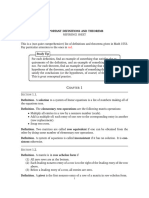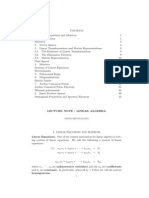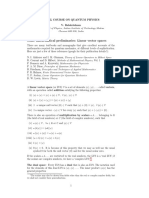4 Pictures of The Same Thing: Picture (I) : Systems of Linear Equations
Uploaded by
thezackattack4 Pictures of The Same Thing: Picture (I) : Systems of Linear Equations
Uploaded by
thezackattack4 Pictures of the same thing
Most of Chapter 1 has been concerned with looking at the same object (a system
of linear equations) in several dierent ways. Heres a summary of whats going
on!
Picture (i): Systems of linear equations
A general system of linear equations is written as
_
_
a
11
+ + a
1n
= b
1
.
.
.
a
m1
+ + a
mn
= b
m
We often eliminate the + and = signs by writing it as an augmented matrix
(i)
_
_
a
11
. . . a
1n
b
1
.
.
.
.
.
.
.
.
.
.
.
.
a
m1
. . . a
mn
b
m
_
_
Picture (ii): Linear combinations of vectors
Vectors in R
d
A d-dimensional vector v is an object with a length and a direction. By taking
v
1
, . . . , v
d
to be its components in the x
1
, . . . , x
d
directions we can write any v
as
v =
_
_
v
1
.
.
.
v
d
_
_
We can identify any d-dimensional vector v with a unique point
(v
1
, . . . , v
d
) R
d
and hence we often talk about d-dimensional vectors as elements of R
d
.
When we add two vectors we add each component seperately for example
_
_
1
2
3
_
_
+
_
_
1
0
1
_
_
=
_
_
2
2
2
_
_
1
When we multiply a vector by a scalar we multiply each component by the
scalar. For example
3
_
_
1
2
3
_
_
=
_
_
3
6
9
_
_
Spans and linear independence
We dene the span of a set of vectors a
1
, . . . , a
n
to be the set of all vectors v
that can be written as a linear combination of these vectors, that is to say
v =
n
j=1
a
j
x
j
for real numbers x
1
, . . . , x
n
We denote the span by
sp{a
1
, . . . , a
n
}
A collection of vectors a
1
, . . . , a
n
is said to be linearly independent if the
only solution to
n
j=1
a
j
x
j
= 0
is given by x
1
= = x
n
= 0.
Writing the system (i) with vectors
Returning to our system (i), dene m-dimensional vectors
a
j
=
_
_
a
1j
.
.
.
a
mj
_
_ for j = 1, . . . , n
and the vector
b =
_
_
b
1
.
.
.
b
m
_
_
Then our system can be written as
(ii) a
1
x
1
+ +a
n
x
n
= b
2
Picture (iii): Matrix equations
Matrices and applying matrices to vectors
We dene an m n matrix A to be a collection of m rows and n columns of
numbers. For example
A =
_
_
a
11
. . . a
1n
.
.
.
.
.
.
.
.
.
a
m1
. . . a
mn
_
_
Given an n-dimensional vector
x =
_
_
x
1
.
.
.
x
n
_
_
and taking the columns of the matrix to be the m-dimensional vectors a
1
, . . . , a
n
A =
_
a
1
. . . a
n
we can apply the matrix to the vector by
Ax =
n
j=1
a
j
x
j
A way to think about matrices applied to vectors is to set
y = Ax
then each coecient a
ij
is the amount of the component of the input x
j
in
the component of the output y
i
. Each column of the matrix corresponds to an
input variable x
j
and each row to an output variable y
i
.
Writing the system (i) with matrices
By taking A as above we note that the left hand side of (ii) is simply Ax and
hence we can re-write the system (i) as
(iii) Ax = b
where b is as above.
Picture (iv): Linear transformations
We say a map T : R
n
R
m
is linear if for any two vectors u, v R
n
and any
scalar R
T(u +v) = T(u) + T(v)
3
A fact that we will use a lot is that for any such linear map T we can nd a
matrix A such that
T(x) = Ax
We call the set of all possible outputs of the map T the range of T. We say
T is onto if the range of T is the whole of R
m
.
We say the map T is one-to-one if there are no non-trivial (non-zero) solu-
tions x to T(x) = 0.
Writing system (i) with linear maps
Given our linear system above and the coecient matrix A we can dene a
linear map by
T(x) = Ax
The system then becomes the equation
(iv) T(x) = b
Existence and uniqueness questions
For each way of writing the system (i) we have a corresponding question about
existence and uniqueness.
The following questions are all equivalent using the 4 dierent pictures of
system (i).
1. Is the system (i) consistent of all choices of b
1
, . . . , b
m
?
2. In (ii), does sp{a
1
, . . . , a
n
} = R
m
?
3. In (iii), does the inhomogeneous equation Ax = b have a solution for all
vectors b R
m
?
4. In (iv), is the linear map T onto?
Similarly, the following questions are all equivalent using the 4 dierent
pictures of system (i).
1. If the system (i) is consistent, is the solution unique?
2. In (ii), are the vectors a
1
, . . . , a
n
linearly independent?
3. In (iii), is the only solution to the homogeneous equation Ax = 0 the
trivial solution?
4. In (iv), is the linear map T one-to-one?
4
You might also like
- Linear Algebra (Bretscher) Chapter 3 Notes: 1 Image and Kernel of A Linear TransformationNo ratings yetLinear Algebra (Bretscher) Chapter 3 Notes: 1 Image and Kernel of A Linear Transformation4 pages
- Mathematical Methods WK 1: Vectors: 1 Linear Vector SpacesNo ratings yetMathematical Methods WK 1: Vectors: 1 Linear Vector Spaces10 pages
- University of Zakho Faculty of Education Department of Mathematics Second Stage Semester 4No ratings yetUniversity of Zakho Faculty of Education Department of Mathematics Second Stage Semester 428 pages
- Kashif Khan Assignment of Linear Algebra.No ratings yetKashif Khan Assignment of Linear Algebra.10 pages
- Linear Equations and Matrices (Week 1-3)No ratings yetLinear Equations and Matrices (Week 1-3)130 pages
- Mathematics of Modern Engineering I Lecture 1No ratings yetMathematics of Modern Engineering I Lecture 17 pages
- Mathematics Part 1 Ready Reckoner Xii Gdgpsd 2024-25No ratings yetMathematics Part 1 Ready Reckoner Xii Gdgpsd 2024-2533 pages
- Appendix A: A.1 Gratuitous Mathematics: Definitions of Vector SpacesNo ratings yetAppendix A: A.1 Gratuitous Mathematics: Definitions of Vector Spaces12 pages
- WIN (2019-20) MAT1002 ETH AP2019205000028 Reference Material I Application of ODE PDFNo ratings yetWIN (2019-20) MAT1002 ETH AP2019205000028 Reference Material I Application of ODE PDF177 pages
- Excel Functions of Decile and PercentileNo ratings yetExcel Functions of Decile and Percentile6 pages
- Reichard et al.(2024).Elevating aspiring diverse leaders through PsyCapNo ratings yetReichard et al.(2024).Elevating aspiring diverse leaders through PsyCap10 pages
- Reference Style - KU - Economics - Discipline - 2015 - 11 - 10-2No ratings yetReference Style - KU - Economics - Discipline - 2015 - 11 - 10-27 pages
- Lectures On Virtual Environment Development L14No ratings yetLectures On Virtual Environment Development L1434 pages
- Consumer Behavior Towards Times of India News PaperNo ratings yetConsumer Behavior Towards Times of India News Paper45 pages
- STAGE 1: Desired Results: VIU Lesson Plan Jerome QUIVYNo ratings yetSTAGE 1: Desired Results: VIU Lesson Plan Jerome QUIVY16 pages
- Relevance of Designing and Developing An Improvised White Board Compass For Teaching Geometrical Construction Concepts in Basic TechnologyNo ratings yetRelevance of Designing and Developing An Improvised White Board Compass For Teaching Geometrical Construction Concepts in Basic Technology6 pages
- Communication Enginnering Questions PDFNo ratings yetCommunication Enginnering Questions PDF32 pages
- Questionnaire For Retailers VAS Value Added Services 1. WhichNo ratings yetQuestionnaire For Retailers VAS Value Added Services 1. Which3 pages
- Pierre Manent The Greatness and Misery of LiberalismNo ratings yetPierre Manent The Greatness and Misery of Liberalism8 pages
- Linear Algebra (Bretscher) Chapter 3 Notes: 1 Image and Kernel of A Linear TransformationLinear Algebra (Bretscher) Chapter 3 Notes: 1 Image and Kernel of A Linear Transformation
- Mathematical Methods WK 1: Vectors: 1 Linear Vector SpacesMathematical Methods WK 1: Vectors: 1 Linear Vector Spaces
- University of Zakho Faculty of Education Department of Mathematics Second Stage Semester 4University of Zakho Faculty of Education Department of Mathematics Second Stage Semester 4
- Mathematics Part 1 Ready Reckoner Xii Gdgpsd 2024-25Mathematics Part 1 Ready Reckoner Xii Gdgpsd 2024-25
- Appendix A: A.1 Gratuitous Mathematics: Definitions of Vector SpacesAppendix A: A.1 Gratuitous Mathematics: Definitions of Vector Spaces
- WIN (2019-20) MAT1002 ETH AP2019205000028 Reference Material I Application of ODE PDFWIN (2019-20) MAT1002 ETH AP2019205000028 Reference Material I Application of ODE PDF
- An Introduction to Linear Algebra and TensorsFrom EverandAn Introduction to Linear Algebra and Tensors
- A-level Maths Revision: Cheeky Revision ShortcutsFrom EverandA-level Maths Revision: Cheeky Revision Shortcuts
- Reichard et al.(2024).Elevating aspiring diverse leaders through PsyCapReichard et al.(2024).Elevating aspiring diverse leaders through PsyCap
- Reference Style - KU - Economics - Discipline - 2015 - 11 - 10-2Reference Style - KU - Economics - Discipline - 2015 - 11 - 10-2
- Consumer Behavior Towards Times of India News PaperConsumer Behavior Towards Times of India News Paper
- STAGE 1: Desired Results: VIU Lesson Plan Jerome QUIVYSTAGE 1: Desired Results: VIU Lesson Plan Jerome QUIVY
- Relevance of Designing and Developing An Improvised White Board Compass For Teaching Geometrical Construction Concepts in Basic TechnologyRelevance of Designing and Developing An Improvised White Board Compass For Teaching Geometrical Construction Concepts in Basic Technology
- Questionnaire For Retailers VAS Value Added Services 1. WhichQuestionnaire For Retailers VAS Value Added Services 1. Which
- Pierre Manent The Greatness and Misery of LiberalismPierre Manent The Greatness and Misery of Liberalism

























































































